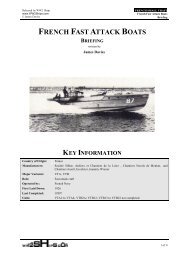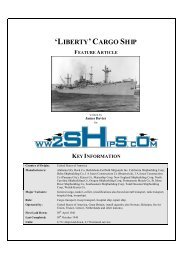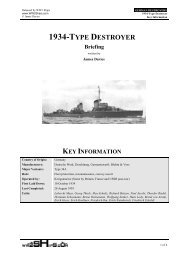'liberty'cargo ship briefing - World War Two Ships
'liberty'cargo ship briefing - World War Two Ships
'liberty'cargo ship briefing - World War Two Ships
Create successful ePaper yourself
Turn your PDF publications into a flip-book with our unique Google optimized e-Paper software.
Released by WW2 <strong>Ships</strong><br />
www.WW2<strong>Ships</strong>.com<br />
© James Davies<br />
‘LIBERTY’ CARGO SHIP<br />
Country of Origin: United States of America<br />
BRIEFING<br />
written by<br />
James Davies<br />
Key Information<br />
US OTHER SHIPS<br />
'Liberty' Cargo Ship<br />
Key Information<br />
Manufacturers: Alabama Dry Dock Co, Bethlehem-Fairfield Shipyards Inc, California Shipbuilding Corp,<br />
Delta Shipbuilding Co, J A Jones Construction Co (Brunswick), J A Jones Construction<br />
Co (Panama City), Kaiser Co, Marin<strong>ship</strong> Corp, New England Shipbuilding Corp, North<br />
Carolina Shipbuilding Co, Oregon Shipbuilding Corp, Permanente Metals Co, St Johns<br />
River Shipbuilding Co, Southeastern Shipbuilding Corp, Todd Houston Shipbuilding<br />
Corp, Walsh-Kaiser Co.<br />
Major Variants: General cargo, tanker, collier, (modifications also boxed aircraft transport, tank transport,<br />
hospital <strong>ship</strong>, troop<strong>ship</strong>).<br />
Role: Cargo transport, troop transport, hospital <strong>ship</strong>, repair <strong>ship</strong>.<br />
Operated by: United States of America, Great Britain, (small quantity also Norway, Belgium, Soviet<br />
Union, France, Greece, Netherlands and other nations).<br />
First Laid Down: 30 th April 1941<br />
Last Completed: 30 th October 1945<br />
Units: 2,711 <strong>ship</strong>s laid down, 2,710 entered service.<br />
1 of 4
Released by WW2 <strong>Ships</strong><br />
www.WW2<strong>Ships</strong>.com<br />
© James Davies<br />
Overview<br />
US OTHER SHIPS<br />
'Liberty' Cargo Ship<br />
Overview<br />
In 1936, well over 90% of the American merchant fleet was more than 20 years old. In order to ensure that<br />
America possessed a fleet that was adequate to meet the future anticipated needs a decision was made to greatly<br />
increase the number of American <strong>ship</strong>s. The fleet was to be owned and operated by American companies, and in<br />
order to ensure their success the American government decided to subsidise the building costs and operating<br />
expenses of the <strong>ship</strong>s. As yet there was little urgency in the programme, run by the US Maritime Commission.<br />
In late 1940, desperate for new tonnage to offset losses, British representatives took <strong>ship</strong> plans to America to try<br />
to persuade the American government to let Britain place orders for 60 new <strong>ship</strong>s in US <strong>ship</strong>yards. The<br />
Americans agreed, however no space existed in <strong>ship</strong>yards to allow them to be built and it was decided to build<br />
two new <strong>ship</strong>yards to meet the British need. These <strong>ship</strong>s bore the prefix ‘Ocean’, and the first <strong>ship</strong> (the Ocean<br />
Vanguard) was launched on 15 th October 1941.<br />
Simultaneous with the decision to build <strong>ship</strong>s for the British was a decision to rapidly expand the US merchant<br />
fleet, however the choice of a design appropriate for mass production was a difficult one. The previous <strong>ship</strong>s<br />
built by the US Maritime Commission were of a very high quality (but not suited to mass production), in stark<br />
contrast to the British wartime designs (which deliberately emphasised speed of construction), and there was<br />
considerable resistance to the idea of lowering standards to build <strong>ship</strong>s rapidly. Faced, however, with an urgent<br />
need, little time and a sound and readily available design a common-sense decision was taken to adopt the basic<br />
British concept for the American emergency fleet. This design was modified somewhat to further aid mass<br />
production and to suit American building techniques and other US preferences, and orders were placed for the<br />
first 200 of these <strong>ship</strong>s in early 1941.<br />
As with the ‘Ocean’ <strong>ship</strong>s, no <strong>ship</strong>yards existed to build these vessels and a total of nine new <strong>ship</strong>yards were<br />
announced (including the two required to build the British vessels). Later expansions resulted in even more<br />
<strong>ship</strong>yards, and a total completed fleet of 2,710 <strong>ship</strong>s. It was a project on a massive scale, undertaken with great<br />
speed and efficiency. The first Liberty <strong>ship</strong> (the Patrick Henry) was launched on 27 September 1941 (and<br />
completed on 30 December 1941), which was an incredible feat considering that just seven months previously<br />
neither <strong>ship</strong>yard nor workforce existed to build her.<br />
The <strong>ship</strong>s suffered from some initial structural problems, particularly related to the lack of understanding of the<br />
influence of welding on the strength of some key elements (such as hatch corners), however once the problems<br />
were understood they were soon fixed. Less easy to fix was the 'stiffness' of the <strong>ship</strong>s - they had a rapid roll<br />
motion which was uncomfortable for the crew and could lead to damage to cargo. This could be partially offset<br />
by putting solid ballast in the 'tween decks, thereby raising the centre of gravity and reducing the 'stiffness'.<br />
Unfortunately, if not stowed properly (and sometimes even when stowed properly) this ballast could shift in a<br />
storm and put the <strong>ship</strong> in grave danger of foundering.<br />
A total of 2,710 Liberty <strong>ship</strong>s were completed (with one more being burnt out on the slipway and never<br />
completed). This huge total almost defies the imagination when considering the resources that must be<br />
employed to produce this number. Putting it in perspective, 1,088 Curtis Hawk fighters were produced, and<br />
approximately 2,900 M16 half-tracks. During the peak building period (March 1943 to December 1943) over<br />
100 were completed per month.<br />
Despite being initially labelled an 'ugly duckling' by the newspapers, and intended to be expendable if necessary,<br />
the <strong>ship</strong>s eventually caught the imagination of the public. They proved to be easy to build, reliable and versatile,<br />
exceeding even the most optimistic expectations for their overall contribution to the war effort.<br />
The Liberty <strong>ship</strong> saw service all over the world: they were present in the Atlantic and Russian convoys; they<br />
anchored off the beachheads in North Africa, Europe and in the Pacific islands; they carried food to civilians as<br />
well as supplies and equipment to the armed forces; as hospital <strong>ship</strong>s they treated the wounded; they transported<br />
prisoners away from the fighting; they evacuated rescued Allied prisoners from Asia; in perhaps their most<br />
welcome role, they brought the troops home again after the fighting was over.<br />
2 of 4
Released by WW2 <strong>Ships</strong><br />
www.WW2<strong>Ships</strong>.com<br />
© James Davies<br />
Units<br />
Variant Built Notes<br />
General Cargo<br />
(Original)<br />
Tanker<br />
(Redesign)<br />
Collier<br />
(Redesign)<br />
Troop<strong>ship</strong><br />
(Conversion)<br />
Hospital Ship<br />
(Conversion)<br />
Box Transport<br />
(Conversion)<br />
Repair Ship<br />
(Conversion)<br />
US OTHER SHIPS<br />
'Liberty' Cargo Ship<br />
Units<br />
2316 This is the basic Liberty <strong>ship</strong>, with five cargo holds (three forward, two aft), central<br />
machinery, and a single propeller.<br />
62 The Liberty tanker was proposed in late 1942 as a response to the need to transport more<br />
oil (due to the US entry in to the war) and offset the large losses amongst the existing<br />
tanker fleet. The initial intention was to both convert existing cargo <strong>ship</strong>s and build<br />
specific new tonnage as tankers, however the conversion plan was soon abandoned.<br />
The tanker was very similar to the standard cargo <strong>ship</strong>, with the same length, breadth and<br />
draft, as well as the same propulsion system. It deliberately retained dummy or redundant<br />
deck equipment to prevent these <strong>ship</strong>s from being identified as tankers (and so prevent<br />
them from being specifically targeted), with the necessary piping being concealed. The<br />
deception was further aided by the ability of these <strong>ship</strong>s to carry deck cargo.<br />
24 In contrast to the Liberty tanker (which was produced with minimal changes to meet an<br />
urgent wartime need), the collier represented a major redesign to meet anticipated<br />
peacetime requirements. The Liberty collier's outward appearance had little in common<br />
with the standard Liberty <strong>ship</strong>. The main change was the relocation of all machinery aft.<br />
The <strong>ship</strong> was very slightly longer than the standard vessel, but with the same breadth and<br />
depth. This meant that many of the standard Liberty plates and structural members could<br />
be used for the hull, although some new components were needed.<br />
247 Large amounts of additional transportation were required at relatively short notice to<br />
carry prisoners from North Africa to prisoner of war camps in North America. This<br />
transportation was to be provided by converting existing cargo vessels, with the original<br />
plan calling for the <strong>ship</strong>s to carry 308 prisoners, however this was later raised to 504.<br />
The conversion was relatively simple, with five-tier bunks being added, along with<br />
additional facilities (galleys and sanitary facilities). To provide an essential minimum of<br />
protection in the event of an emergency, additional lifeboats, liferafts and lifejackets were<br />
provided, people were generally not accommodated below the waterline and two<br />
emergency escapes were installed from each compartment.<br />
6 The vessels were essentially floating hospitals, with operating theatres, wards and other<br />
details following the same general requirements as those for shore-based hospitals. As<br />
with the troop<strong>ship</strong>s, additional lifeboats, liferafts, lifejackets and escape routes were<br />
installed. Following international conventions the <strong>ship</strong>s were provided with clear<br />
identifying marks, including an illuminated red cross on the deck.<br />
44 These <strong>ship</strong>s were designed to handle heavier loads than the standard Liberty <strong>ship</strong>, catering<br />
for items of up to 30 tons, and four hatches replaced the normal five. Besides these<br />
modifications, they were little changed from the standard liberty <strong>ship</strong>, although they were<br />
directly operated by the US armed forces rather than by civilian organisations.<br />
11 In a similar way to the hospital <strong>ship</strong>s, who treated damaged people far from norma l<br />
facilities, repair <strong>ship</strong>s were built to maintain equipment away from the normal heavy<br />
repair facilities. Aircraft in particular require frequent heavy maintenance to ensure their<br />
continued operation. As the island-hopping campaign moved closer to Japan, and further<br />
from established bases, the repair <strong>ship</strong>s moved with the forward fields. The British Royal<br />
Navy also requested repair <strong>ship</strong>s (primarily intended to maintain war<strong>ship</strong>s), and five were<br />
built to meet their needs. Three, however, were retained by the US Navy and never<br />
entered British service.<br />
3 of 4
Released by WW2 <strong>Ships</strong><br />
www.WW2<strong>Ships</strong>.com<br />
© James Davies<br />
Dimensions<br />
Specifications<br />
Cargo Tanker Collier<br />
Displacement (Max.) 14,245 tons 14,245 tons 14,730 tons<br />
US OTHER SHIPS<br />
'Liberty' Cargo Ship<br />
Specifications<br />
Length (OA) 441 ft 6 in (129.81 m) 441 ft 6 in (129.81 m) 443 ft 7.5 in (130.43 m)<br />
Length (pp) 417 ft 8.75 in (122.82 m) 417 ft 8.75 in (122.82 m) 417 ft 8.75 in (122.82 m)<br />
Length (WL) 427 ft (125.52 m) 427 ft (125.52 m) 429 ft 3 in (126.20 m)<br />
Beam 57 ft (16.76 m) 57 ft (16.76 m) 57 ft (16.76 m)<br />
[Note 1]<br />
Draft<br />
27 ft 8 7 /8 in (8.16 m) 27 ft 8 7 /8 in (8.16 m) 28 ft 7 1 /8 in (8.41 m)<br />
Block Coefficient 0.745 0.745 0.744<br />
Propulsion 2500 hp (1.86 MW) 2500 hp (1.86 MW) 2500 hp (1.86 MW)<br />
Speed 11 kts 11 kts 11 kts<br />
Cargo Capacity<br />
Deadweight<br />
[Note 2]<br />
10,856 tons 10,674 tons 11,047 tons<br />
Gross tonnes 7,176 tons 7,219 tons 6,643 tons<br />
[Note 3]<br />
Cargo volume 562,608 ft 3 grain (14,297 m 3 ) 272,978 ft 3 (6,937 m 3 ) 472,799 ft 3 (12,015 m 3 )<br />
Miscellaneous<br />
499,573 ft 3 bale (12,695 m 3 )<br />
64,826 barrels<br />
Armament [Note 4] Varies Varies No information<br />
Compliment 81 81 46<br />
Note 1: Draft quoted is maximum normal seagoing draft in peace conditions, and corresponds to the maximum<br />
displacement. This draft may be exceeded in coastal or inland waterways, or by overloading during wartime.<br />
Unladen <strong>ship</strong>s will have a significantly lower draft.<br />
Note 2: As well as cargo weight, deadweight also includes the weight of stores, fuel and other consumables,<br />
although on a cargo <strong>ship</strong> the 'deadweight' is dominated by cargo weight.<br />
Note 3: Cargo volume is quoted in various measures depending on the type of vessel. The 'grain' measurement<br />
is for general dry cargo vessels, and indicates the total volume of the holds, excluding any structural items or<br />
fittings (grain fills in all corners and around structural members). The 'bale' measurement is again for general<br />
dry cargo vessels, however it measures volume up to the stiffeners on the inside of the hull, with space between<br />
stiffeners being lost (bales of cargo don't flow around beams). The 'barrel' is quoted for oil carriers, although in<br />
the modern world oil is now normally measured by the ton.<br />
Note 4: The armament provided varied considerably, and could include four inch and three inch guns, 20mm and<br />
37mm cannon, as well as 0.3 and 0.5 inch machineguns. The largest gun (generally a four inch) would typically<br />
be fitted at the stern, and would be flanked by two smaller guns (such as two single 20 mm cannon). There<br />
would usually be four gun positions on the superstructure, and these could be 20mm cannons, machineguns, or a<br />
mixture of both. The forward mast would be provided with two guns, usually 20mm cannon or 0.5 inch<br />
machineguns. On the bow would often be a single three inch gun. Many variants on this typical arrangement<br />
existed, with additional guns being fitted in other areas (such as two or four guns added adjacent to the second<br />
mast), or the arrangements changed from those described above (such as replacing the single bow gun with two<br />
37mm cannon).<br />
4 of 4







